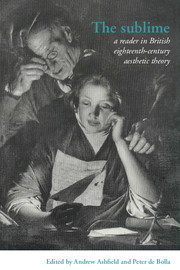Book contents
- Frontmatter
- Contents
- List of Abbreviations
- Introduction
- Part I The Longinian tradition
- Part II Rhapsody to rhetoric
- Part III Irish Perspectives
- Part IV The Aberdonian Enlightenment
- Part V Edinburgh and Glasgow
- Part VI From the Picturesque to the Political
- 41 A dissertation on oriental gardening (1772)
- 42 An essay on the picturesque (1794)
- 43 A review of The landscape (1795)
- 44 The history of the life of William Pitt, Earl of Chatham (1783)
- 45 Enquiry concerning political justice (1798)
- 46 Reflections on the revolution in France (1790)
- 47 A letter from the right honourable Edmund Burke to a noble lord (1796)
- 48 A vindication of the rights of man (1790)
- 49 Letters written in France (1790)
- 50 A tour in Switzerland (1798)
- Sources and further reading
42 - An essay on the picturesque (1794)
Published online by Cambridge University Press: 05 June 2012
- Frontmatter
- Contents
- List of Abbreviations
- Introduction
- Part I The Longinian tradition
- Part II Rhapsody to rhetoric
- Part III Irish Perspectives
- Part IV The Aberdonian Enlightenment
- Part V Edinburgh and Glasgow
- Part VI From the Picturesque to the Political
- 41 A dissertation on oriental gardening (1772)
- 42 An essay on the picturesque (1794)
- 43 A review of The landscape (1795)
- 44 The history of the life of William Pitt, Earl of Chatham (1783)
- 45 Enquiry concerning political justice (1798)
- 46 Reflections on the revolution in France (1790)
- 47 A letter from the right honourable Edmund Burke to a noble lord (1796)
- 48 A vindication of the rights of man (1790)
- 49 Letters written in France (1790)
- 50 A tour in Switzerland (1798)
- Sources and further reading
Summary
Chapter III
There are few words whose meaning has been less accurately determined than that of the word Picturesque.
In general, I believe, it is applied to every object, and every kind of scenery, which has been, or might be represented with good effect in painting, and that without any exclusion. But, considered as a separate character, it has never yet been accurately distinguished from the sublime and the beautiful; though as no one has ever pretended that they are synonymous, (for it is sometimes used in contradistinction to them) such a distinction must exist ….
The principles of those two leading characters in nature, the sublime and the beautiful, have been fully illustrated and discriminated by a great master; but even when I first read that most original work, I felt that there were numberless objects which give great delight to the eye, and yet differ as widely from the beautiful as from the sublime. The reflections I have since been led to make have convinced me that these objects form a distinct class, and belong to what may properly be called the picturesque.
That term (as we may judge from its etymology) is applied only to objects of sight, and that indeed in so confined a manner as to be supposed merely to have a reference to the art from which it is named.
- Type
- Chapter
- Information
- The SublimeA Reader in British Eighteenth-Century Aesthetic Theory, pp. 271 - 275Publisher: Cambridge University PressPrint publication year: 1996



